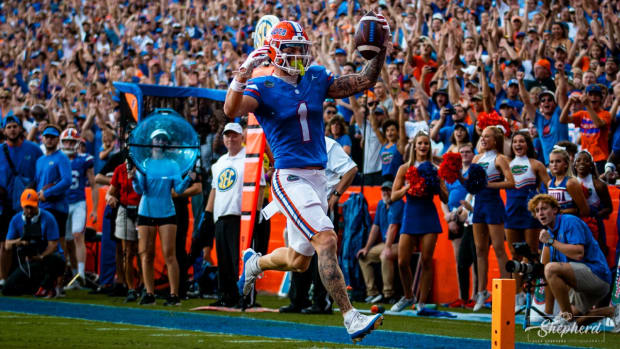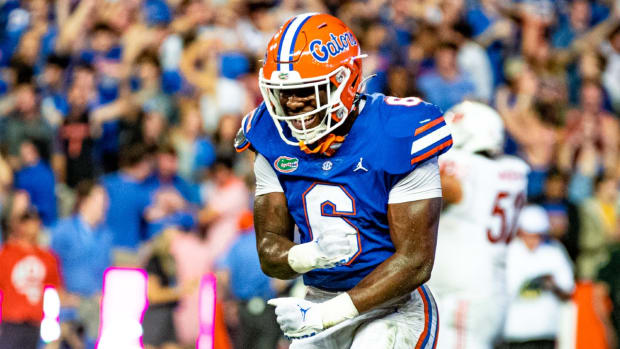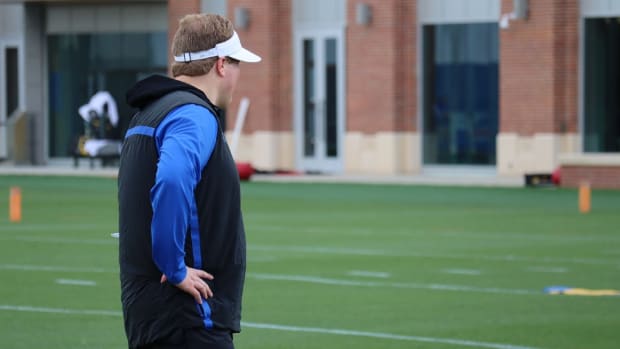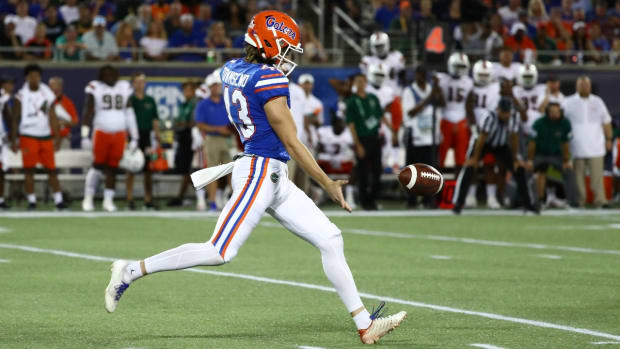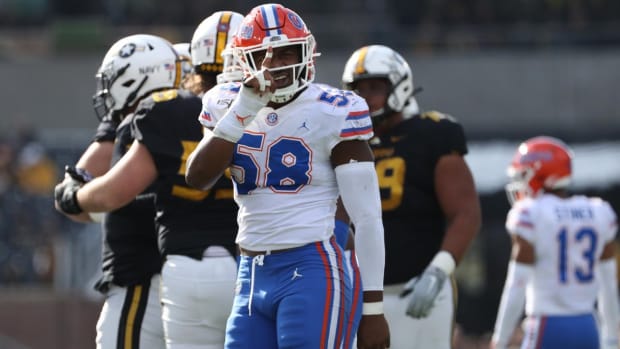How Can Emory Jones and the Florida Gators Fix Their Deep Passing Woes?
Photo credit: Alex Shepherd
Throughout the offseason, Dan Mullen was adamant that the Gators would not be a one-dimensional team offensively in 2021.
That was the case a year ago, but for great reason: Florida owned the best passing offense in the FBS, with future early draft picks in quarterback Kyle Trask, wide receiver Kadarius Toney and tight end Kyle Pitts posting elite production while offensive linemen Stone Forsythe and Brett Heggie provided stellar protection.
Those players and several other meaningful contributors are no longer around, though. With a dual-threat in Emory Jones taking over at quarterback and ample talent returning at running back, a switch was expected to be flipped: UF was projected to become a run-oriented team.
That projection came to fruition: Through five games, Florida owns the nation's No. 3 rushing offense. However, the fear that UF would be one-dimensional has also come true: The Gators' passing offense ranks No. 81 in the country right now, and in the modern era of football, teams need a strong passing offense in order to compete for championships.
Jones got off to a rocky start this season with four interceptions in the first two games, but has consistently improved as a manager of the team's passing offense. His decision-making has gotten better, his timing on short-to-intermediate routes is enhancing, and when he needs to, Jones can tuck the ball and run.
What is lacking is the threat of deep passes and explosive plays through the air. Those plays were specifically missing in the loss to Kentucky on Saturday, which appeared to be a product of Mullen's game plan. He offered some insight into the lack of deep passes on Monday, following the loss.
"You look at the last game, they were playing a lot of one-high, deep soft coverage," Mullen said. "So, schematically, they’re just bailing everybody really deep so you’re not going to just launch it into coverage downfield.”
Mullen's explanation makes a lot of sense in a vacuum. The issue is, at least from AllGators' analysis of the Kentucky, Tennessee and Alabama games, opponents have not consistently played prevent defense against Florida this season like the Wildcats did. And yet, Jones has not attempted to push the ball deep much at all.
To Jones' credit, he operated really well within Mullen's game plan against Kentucky's pass defense. Aside from his interception on an intermediate seam pass later in the contest, Jones was accurate and timely for the majority of the game and hit on intermediate throws quite often, despite the number of Wildcat defenders dropping back and narrowing throwing windows.
Penalties primarily called on the offensive line, including eight false starts, hampered any progress Jones and the Gators' offense made in the matchup.
Asked about it on Tuesday, Jones summed the deep passing issue up as, well, a non-issue, pointing to his improvement as a manager of the offense and not trying to force throws that aren't there.
"Me as a quarterback, I learned to take what the defense is giving me," Jones explained. "And it might have been a couple of times I could have took some shots or risked some things, but I've learned throughout the year to — I don’t always need to force things when it's not there, or it’s not given to me."
Jones' thought process is a good one to have as a quarterback. However, the numbers speak for themselves - without the threat of explosive passing plays, Florida's offense is finite.
According to Pro Football Focus, just 12 of Jones' 134 passing attempts this season have targeted a receiver 20 or more yards down the field. Three of those 12 attempts were completed, resulting in 88 yards, a touchdown, and two interceptions.
Is this a product of the game plan, or due to a lack of trust in Jones? On film, both appeared to have been the case against Kentucky.
But by the raw numbers, it is sensical that Mullen has not incorporated the deep ball much into the offense with Jones as his starting quarterback. However, the sample size is far too limited to come to the conclusion that Jones isn't capable of improving his deep ball production. As Mullen said all offseason, Jones has a “cannon” for an arm.
And if the deep throws aren't there for Jones to make, Mullen must find a way to create those opportunities schematically.
One way or another, Mullen has vocally expressed confidence that Jones can make these passes.
"I trust him throwing the ball deep down the field," Mullen said after being presented the numbers above on Monday.
If Mullen truly does trust Jones with the deep ball, the head coach must find a way to put his quarterback in situations to make those throws.
It isn't a guarantee, but there may be a method that Florida can utilize to create deeper passing plays with Jones at the helm: Increasing its usage of play-action passes. Particularly, extended play-action where Jones can use his legs to move the pocket and receivers have time to run deeper routes.
Jones has been more productive throwing the ball further down the field on play-action than on standard dropbacks, with a minimal drop-off in completion percentage and - as expected - a higher risk of committing a turnover. We'll touch more on Jones' turnover-worthy plays later in this analysis.
Below are Jones' stats split between non-play-action and play-action throws, via PFF.
- Non-play-action (103 dropbacks): 62-of-90 (68.9 percent), 517 yards, 5.7 yards per attempt, three touchdowns, four interceptions, 3.8 turnover-worthy play percentage (out of 100), 7.5 yards of average depth of target.
- Play-action (51 dropbacks): 31-of-46 (67.4 percent), 354 yards, 7.7 yards per attempt, two touchdowns, two interceptions, 5.5 turnover-worthy play percentage, 8.7 yards of average depth of target.
For reference, PFF defines turnover-worthy plays as "a pass that has a high percentage chance to be intercepted or a poor job of taking care of the ball and fumbling." Average depth of target is exactly what it sounds like: However many yards down the field that a quarterback is targeting a specific receiver, on average.
A two-yard difference in yards per attempt and a 1.2-yard difference in ADOT might not seem like much, but they are. For comparison's sake, Jones' passes on play-action are traveling 13.7 percent further than his non-play-action throws. His yards per attempt also increases by 26 percent on play-action.
Consider this: Ole Miss quarterback Matt Corral is viewed as one of the best deep-ball passers in college football. His ADOT this season, on all of his throws, is 8.4 yards.
Even if these throws aren't bombs down the field, the potential for explosive plays is greater when Jones runs play-action compared to when he doesn't.
Per PFF, of the quarterbacks who have played at least 50 percent of their team's snaps this year (62 in total), Jones ranks tied for No. 17 in the country with a play-action dropback rate of 33.1 percent. That might seem good enough, but consider this: The top seven quarterbacks in these rankings, including the likes of Corral, North Carolina's Sam Howell, Oklahoma's Spencer Rattler, all surpass the 50 percent mark.
Corral, whose play-action dropback rate is the second-highest in the country, nearly doubles Jones' at 61.8 percent.
Jones' completion percentage on play-action passes ranks No. 20 among the qualifying QBs and is 9.6 percent better than Howell's (57.8 percent), three percent below Corral's (70.4) and 5.8 percent below Rattler's (73.2). Jones' play-action ADOT is less than a yard below Corral (8.2 yards) and Rattler's (8.5), while Howell's ADOT (14.2) is almost twice as high as Jones' mark, yet Howell has been far less accurate in these situations.
Some of the best quarterbacks in the country are significantly outpacing Jones on play-action dropbacks, yet Jones is operating at a similarly high level on such play calls. Jones also possesses a skill-set akin to these quarterbacks as he is mobile and possesses a strong arm.
The biggest question mark with PFF's stats is whether or not the outlet lumps run-pass options into its play-action tracker. Jones has run a mix of both concepts, but it would appear that Jones would benefit from more true play-action calls than RPOs.
RPOs aren't designed to create deep passes, instead, they require fast decisions and quick throws. Play-action, meanwhile, can be extended with roll-outs and designs to move the pocket across the backfield, while receivers can push down the field.
Given Jones' speed and elusiveness, paired with an ability to throw with velocity on the run, play-action should be the preference.
Defenses will bite on the run fake should Mullen take this route - there is no doubt about it, due to the potency of UF's rushing attack. Mullen can make use of the running game to bring out the best in Jones as a passer and draw defenders out of coverage to create deep openings.
Accomplishing that feat will force defenses to respect the pass far more, which, in return, can open up even more possibilities for UF on the ground.
This strategy wasn't put to use enough against Kentucky, as Jones tied his season-low of six play-action dropbacks. Although the lack of play-action wasn’t the complete reason why (and by the way, the concept does work without a strong ground attack), Florida also posted a season-low of 171 rushing yards and 4.4 yards per carry versus the Wildcats. It was an admirable performance in the run game, but not up to UF’s standard.
Circling back to turnover-worthy plays, Jones has also progressed to a point where the positives of taking risks with the deep ball outweigh the negatives - in this case, throwing an interception.
Against FAU and USF in his first two games as a starter, Jones' TWP percentage was 11.4 percent. Across the three games since, each opponent being an SEC team, Jones' TWP percentage comes in at 0.93 percent. He didn't commit a single turnover-worthy play against Alabama and Tennessee (remember, Jones was hit as he threw on his interception vs. the Crimson Tide, negating a TWP), and posted just one against Kentucky - his third-quarter pick.
From AllGators' film evaluation, paired with the stats above, Jones has undoubtedly improved as this season has gone on and is executing the provided game plan at a high level. The issue is that the game plan has been limited, even though Jones' decision-making has gotten better and his turnover-worthy plays have diminished.
Considering Jones' improvements and the need for explosive passing plays, Mullen can turn to an uptick in play-action calls to best utilize Jones' skill-set while simultaneously creating opportunities for deep passes.
Jones seemingly plays his best football on play-action designs. Those plays simply aren't being called enough.
Stay tuned to AllGators for continuous coverage of Florida Gators football, basketball and recruiting. Follow along on social media at @SI_AllGators on Twitter and Florida Gators on Sports Illustrated on Facebook.


